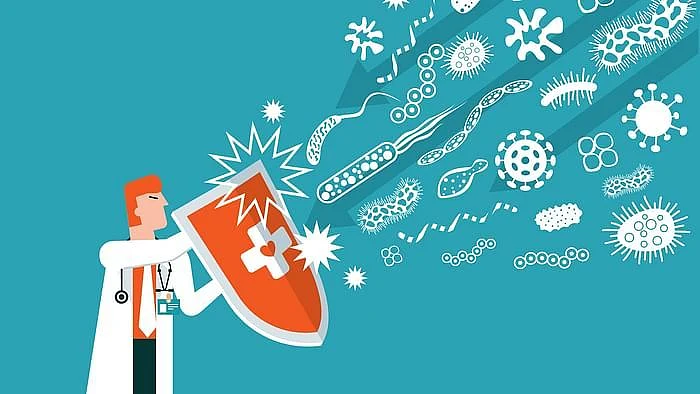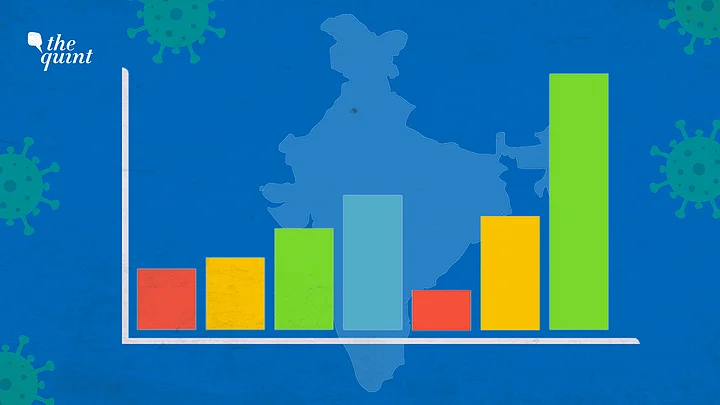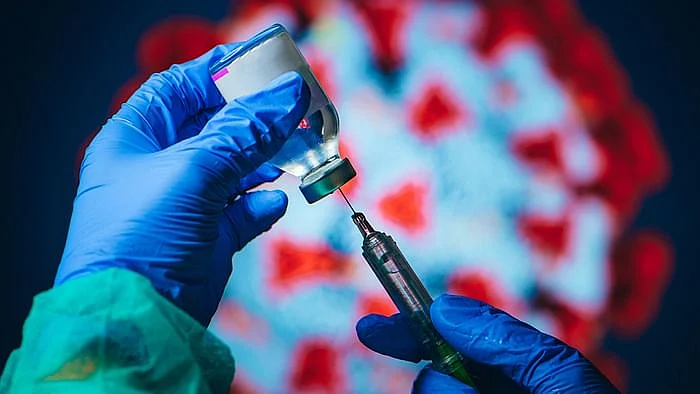Recently, headlines have screamed at us with news of a COVID-19-induced fungal bacteria that makes patients lose their eyes, and their lives. After Delhi, the latest report is from Gujarat where nine people are believed to have lost their lives to a 'black' fungal infection.
But do we have reason to worry? FIT speaks to Sir Ganga Ram Hospital’s ENT Dr Manish Munjal and Dr Sumit Ray, a senior consultant of Critical Care Medicine at Holy Family Hospital in Delhi, who runs a COVID ward, to find out.
Let’s break down what mucormycosis really is, what more information we need before we panic, and signs to watch out for.
Explained: What is the ‘Deadly Fungal Infection’ Linked to COVID?
1. What is Mucormycosis?
First, let’s look at what the fungal infection or mucormycosis really is.
According to the US’s Center for Disease Control and Prevention (CDC), mucormycosis is a serious but rare fungal infection caused by a group of moulds which live in the environment called micromycetes.
“Mucormycosis mainly affects people who have health problems or take medicines that lower the body’s ability to fight germs and sickness. It most commonly affects the sinuses or the lungs after inhaling fungal spores from the air, or the skin after the fungus enters the skin through a cut, burn, or other type of skin injury. However, it can occur in nearly any part of the body.”
CDCIt has long been a cause of death and disease in many patients in regular transplants, or ICUs and in immunodeficient people.
Dr Ray adds that it is a “devastating infection and loss of eyesight, penetration to the brain and major surgeries to correct it are common.”
“The mortality in those infected with mucor is very, very high – almost 50-70 percent.”
Dr Sumit Ray, Intensivist, Holy Family Hospital, DelhiExpand2. What's the Link Between COVID-19 & Mucormycosis?
Mucormycosis, also known as ‘black fungus’, has been a cause of disease and death in transplants, ICU and immunodeficient individuals, but its potential links to recovering COVID patients is a cause of concern.
Dr Ray adds that it is not difficult to pick up the infection in hospitals, but it is worrying that there is a cluster of the same issue in certain hospitals.
So, we know that mucor is not a new infection, but should we worry at the potential of COVID triggering the infection? Cases of COVID patients with mucor have been reported in Delhi, Mumbai and Ahmedabad.
Dr Ray says:
“The possibility of mucormycosis in COVID patients is there because the maximum number of patients with severe disease are diabetics and they are put on steroids which causes immunosuppression – and here they can get mucormycosis. But is is not a common infection – we haven’t seen a very high incidence in most of the places across the world and in India.”
Dr Sumit Ray, Intensivist, Holy Family Hospital, DelhiExpand3. Questions to Ask Before Panicking
It’s always best to wait for more data before rushing to conclusions. Dr Ray adds that there are some key questions missing that we need answers to before we panic.
“We need to know if the affected patients had other co-morbidities and if they were immunocompromised from before. Were they on other immunosuppressants other than the steroids? Were they transplant patients?”
Dr Sumit Ray, Intensivist, Holy Family Hospital, DelhiWhat’s important to note is that SGRH has many transplant patients – so there may be a selection bias. “But it is worrying and unfortunate,” adds Dr Ray.
Another important question to note is if there is some mould or hygiene issue in the ICUs or wards of the hospitals with high incidences of mucor patients. This is not improbable as most hospitals have converted their older buildings into COVID wards or hospitals, and the possibility of mould from the walls or floor is high, especially given the overburdened healthcare system.
Additionally, many COVID patients stay in the ICU for long periods of time and can pick up mucor – although it is not that common – from the environment there.
So, we need to see if this is an environmental issue specific to the sites or if the patients were already significantly immunocompromised and on other immunosuppressants to find out if it’s not just COVID and the steroids causing the mucormycosis.
Expand4. When Should You Worry?: Signs To Look Out For in Recovered COVID Patients
One of the worrying signs of this news is that is it affecting recovered covid patients who are unsuspecting and assuming all is well. Here are a few signs to stay alert for even when you feel like letting your guard down post-recovery.
“Early clinical suspicion on symptoms such as nose obstruction, swelling in the eye or cheeks, and black dry crusts in the nose should immediately prompt the conduct of a biopsy in the OPD and start of the Antifungal therapy as early as possible”.
Dr Manish Munjal, Senior ENT surgeon, Sir Ganga Ram HospitalDr Shaloo Bageja, Senior Eye surgeon, Sir Ganga Ram Hospital adds, “Orbital involvement is a grave development in the course of this disease, and points not only towards the possibility of permanent loss of eyesight but life as well because brain involvement is the leading cause of death in mucormycosis.”
It’s essential to identify the signs early because reviving a patient with mucor requires difficult surgeries, and besides, they already have a lower immunocompetence from surviving COVID.
(The article was first published in FIT and has been republished with permission)
(At The Quint, we question everything. Play an active role in shaping our journalism by becoming a member today.)
Expand
What is Mucormycosis?
First, let’s look at what the fungal infection or mucormycosis really is.
According to the US’s Center for Disease Control and Prevention (CDC), mucormycosis is a serious but rare fungal infection caused by a group of moulds which live in the environment called micromycetes.
“Mucormycosis mainly affects people who have health problems or take medicines that lower the body’s ability to fight germs and sickness. It most commonly affects the sinuses or the lungs after inhaling fungal spores from the air, or the skin after the fungus enters the skin through a cut, burn, or other type of skin injury. However, it can occur in nearly any part of the body.”CDC
It has long been a cause of death and disease in many patients in regular transplants, or ICUs and in immunodeficient people.
Dr Ray adds that it is a “devastating infection and loss of eyesight, penetration to the brain and major surgeries to correct it are common.”
“The mortality in those infected with mucor is very, very high – almost 50-70 percent.”Dr Sumit Ray, Intensivist, Holy Family Hospital, Delhi
Mucormycosis, also known as ‘black fungus’, has been a cause of disease and death in transplants, ICU and immunodeficient individuals, but its potential links to recovering COVID patients is a cause of concern.
Dr Ray adds that it is not difficult to pick up the infection in hospitals, but it is worrying that there is a cluster of the same issue in certain hospitals.
What's the Link Between COVID-19 & Mucormycosis?
So, we know that mucor is not a new infection, but should we worry at the potential of COVID triggering the infection? Cases of COVID patients with mucor have been reported in Delhi, Mumbai and Ahmedabad.
Dr Ray says:
“The possibility of mucormycosis in COVID patients is there because the maximum number of patients with severe disease are diabetics and they are put on steroids which causes immunosuppression – and here they can get mucormycosis. But is is not a common infection – we haven’t seen a very high incidence in most of the places across the world and in India.”Dr Sumit Ray, Intensivist, Holy Family Hospital, Delhi
On Monday, 14 December, doctors from Sir Ganga Ram Hospital (SGRH) found 13 cases of “COVID-19-triggered mucormycosis". Patients who were recovering from COVID were found to be diagnosed with a deadly fungal infection allegedly triggered by COVID-19 which made almost half the patients lose their eyesight.
On Friday, 18 December, News18 reported that 44 recent cases of mucormycosis resulted in nine deaths in Ahmedabad.
What is worrying is the increase in mucormycosis in unsuspected recovering COVID-19, said officials from Sir Ganga Ram Hospital (SGRH).
In last 15 days ENT surgeons at SGRH have reported 13 cases of “COVID triggered mucormycosis” with over 50 percent patients’ with loss of eyesight and removal of their nose and jaw bone.
So far, 5 patients have lost their lives putting the morality in the range of 50 percent. A statement by SGRH has said that when the infection travels to the brain there is certain death.
“The frequency with which we are witnessing the occurrence of COVID triggered mucormycosis with high morbidity & mortality has never been seen before and is shocking and alarming”.Dr. Manish Munjal, Senior ENT surgeon, Sir Ganga Ram Hospital
Questions to Ask Before Panicking
It’s always best to wait for more data before rushing to conclusions. Dr Ray adds that there are some key questions missing that we need answers to before we panic.
“We need to know if the affected patients had other co-morbidities and if they were immunocompromised from before. Were they on other immunosuppressants other than the steroids? Were they transplant patients?”Dr Sumit Ray, Intensivist, Holy Family Hospital, Delhi
What’s important to note is that SGRH has many transplant patients – so there may be a selection bias. “But it is worrying and unfortunate,” adds Dr Ray.
Another important question to note is if there is some mould or hygiene issue in the ICUs or wards of the hospitals with high incidences of mucor patients. This is not improbable as most hospitals have converted their older buildings into COVID wards or hospitals, and the possibility of mould from the walls or floor is high, especially given the overburdened healthcare system.
Additionally, many COVID patients stay in the ICU for long periods of time and can pick up mucor – although it is not that common – from the environment there.
So, we need to see if this is an environmental issue specific to the sites or if the patients were already significantly immunocompromised and on other immunosuppressants to find out if it’s not just COVID and the steroids causing the mucormycosis.
When Should You Worry?: Signs To Look Out For in Recovered COVID Patients
One of the worrying signs of this news is that is it affecting recovered covid patients who are unsuspecting and assuming all is well. Here are a few signs to stay alert for even when you feel like letting your guard down post-recovery.
“Early clinical suspicion on symptoms such as nose obstruction, swelling in the eye or cheeks, and black dry crusts in the nose should immediately prompt the conduct of a biopsy in the OPD and start of the Antifungal therapy as early as possible”.Dr Manish Munjal, Senior ENT surgeon, Sir Ganga Ram Hospital
Dr Shaloo Bageja, Senior Eye surgeon, Sir Ganga Ram Hospital adds, “Orbital involvement is a grave development in the course of this disease, and points not only towards the possibility of permanent loss of eyesight but life as well because brain involvement is the leading cause of death in mucormycosis.”
It’s essential to identify the signs early because reviving a patient with mucor requires difficult surgeries, and besides, they already have a lower immunocompetence from surviving COVID.
(The article was first published in FIT and has been republished with permission)
(At The Quint, we question everything. Play an active role in shaping our journalism by becoming a member today.)




